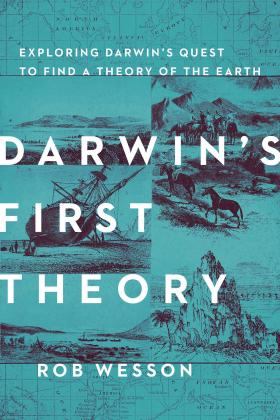Rob Wesson - Darwin's First Theory
Rob Wesson 2017. Darwin’s First Theory. Exploring Darwin’s quest to find a theory of the earth. New York: Pegasus Books, 457 pp.

Darwin’s first love, geology, is supposedly the focus of Rob Wesson’s book but there are an awful lot of digressions into well-known Darwiniana and FitzRoyiana. These chatty asides provide a pretty complete view of the Beagle voyage and aftermath which will make for a very interesting read to someone who knows little of the subject. They also enable the author to turn the original material on Darwin’s geological interests into a very readable book length treatment. For those only wanting to dig out the information on Darwin’s original contributions to geology, however, it is frustrating to have this stuff in the way. It also shows how hard it is to write something original about Charles Darwin.
Anyway, the bones of Darwin’s geological contributions are significant and all follow from his insightful understanding of the significance of uplift (and subsidence) in explaining so much in geomorphology. Lyell’s iconic example is the marine bivalve borings in the exposed columns of the Temple of Serapis but Darwin and others were already on board.
Darwin’s first excursion into geomorphology was an interest in the “Parallel Roads” in Glen Roy, Scotland. These are now recognised as being scars due to glaciers, as explained by Agassiz but Darwin was sort of close, supposing that they were ancient shoreline scars due to floating sea ice. Perhaps most importantly, these and many other examples show Darwin’s incessant curiosity and willingness, when the evidence demanded, to embrace explanations that many would have seen by many as unbelievable.
When the Beagle was in South America, Darwin experienced the 1835 earthquake in Chile and saw the evidence that uplift is often associated with earthquakes. He discovered that uplift and subsidence explained many geological forms including raised shorelines, the presence of marine fossils high up the Andes and the famous example of the formation of coral reefs and atolls.
On the subject of explaining the mechanism behind uplift, the modern fad of invoking lateral tectonic motion and collision of plates to explain uplift would have it that Darwin was wrong. Rob Wesson concisely explains plate tectonics and of course agrees with the consensus of geologists that this is the principal mechanism. But as expansionists assert, Darwin’s explanation that movements in molten magma within the earth result in uplift (and subsidence) is the simpler and in most cases sufficient explanation. After all, is it believable that convection forces within the mantle could somehow turn into lateral vectors, move plates and create the ~ 70% of the crust that is younger than 65 Ma, and all the time keep the diameter of the earth constant? I don’t think so, and it would be great to be able to chat to Darwin about it.
The idea that molten magma could exist within the earth is yet another example of Darwin’s original thinking. It seems he was one of the first to propose this. Rob Wesson suggests that he may have first heard the idea from astronomer John Hershel who he met in South Africa during the Beagle voyage. Charles Babbage, another contemporary, was also a convert and had written then retracted, a paper on thermal expansion and contraction as an explanation of vertical movements at the Temple of Serapis.
Accounts of Rob Wesson’s own research and travel gathering evidence of modern and historical earthquakes and tsunamis are interspersed through the book and I found these interesting, and only confirmed recent original publications (on earthquakes in Chile, New Zealand) that the net result of most earthquakes is uplift. Just as one would expect on an expanding planet.
Rob Wesson is an emeritus geologist with the United States Geological Survey, working on earthquakes and earthquake risk. There are many pages of endnotes and an extensive bibliography.


